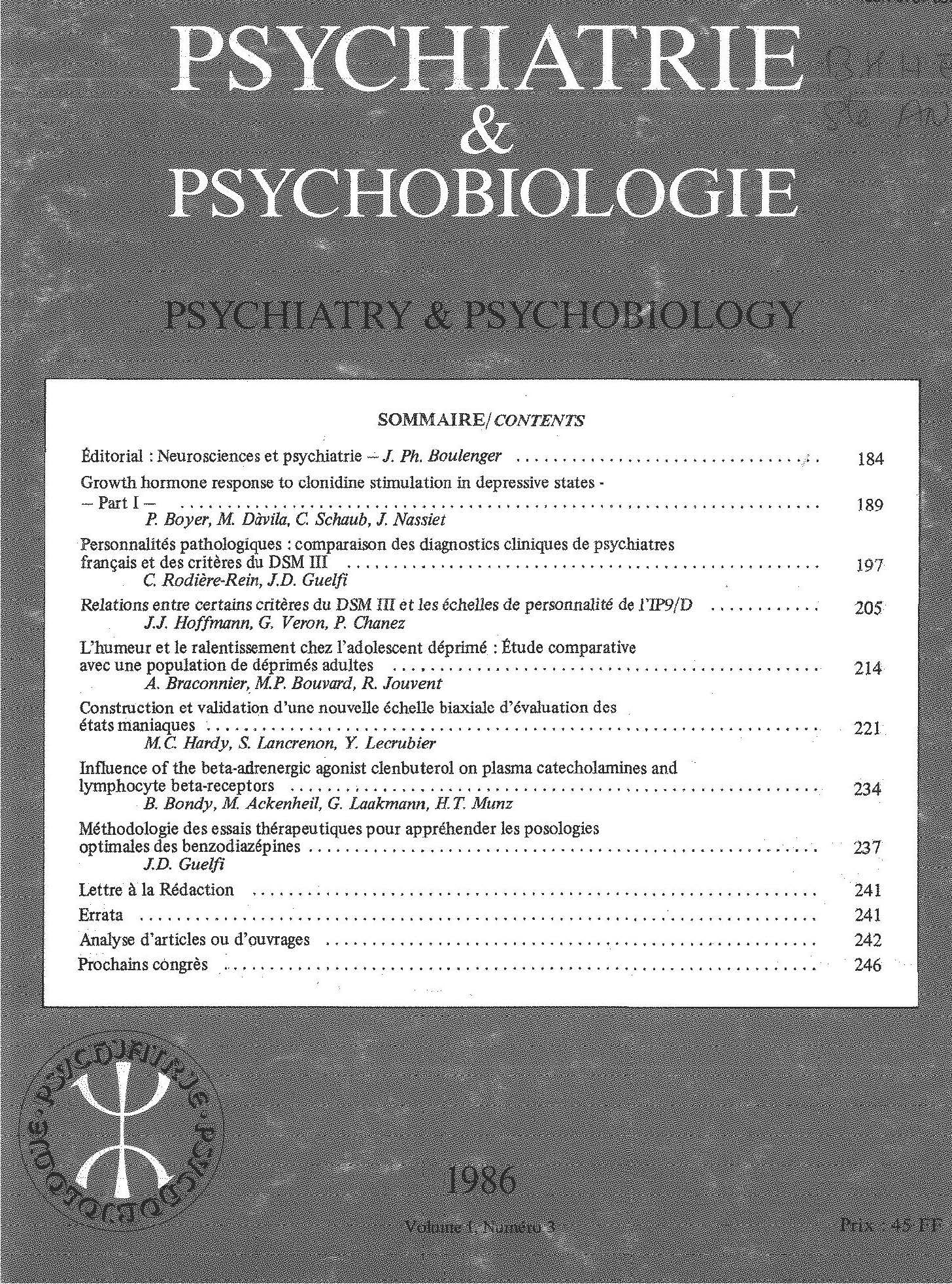No CrossRef data available.
Article contents
Évaluation de la réactivité des récepteurs bêta-adrénergiques cardiaques chez des sujets déprimés
Published online by Cambridge University Press: 28 April 2020
Résumé
L’activité d’un système de neurotransmetteurs dépend à la fois de la quantité de neuromédiateur présent dans la fente synaptique et de la réactivité de l’ensemble récepteur-post récepteur. Dans le cadre de l’hypothèse noradrénergique des états dépressifs, la majorité des études ont eu pour objectif de mettre en évidence une diminution de libération de noradrénaline, et peu d’études se sont intéressées à la réactivité des récepteurs adrénergiques. Une hypersensibilité pourrait exister, réactionnelle à une diminution de noradrénaline présente dans la fente synaptique ; une hyposensibilité chez certains patients pourrait expliquer un hypofonctionnement noradrénergique tout autant qu’une diminution de libération de la noradrénaline. Par ailleurs, l’effet thérapeutique des antidépresseurs semble être en relation avec la stimulation des récepteurs bêta-adréneigiques centraux. L’effet thérapeutique des antidépresseurs pourrait donc varier selon la réactivité initiale de ces récepteurs avant traitement.
En l’absence de modèle de mesure de la réactivité des récepteurs bêta-adrénergiques centraux, l’étude de la dose d’isoprénaline nécessaire pour augmenter de 20 battements par minute la fréquence cardiaque (DE20), a été utilisée ici comme index de réactivité des systèmes bêta-adrénergiques. Chez des malades déprimés sans traitement antidépresseur, la DE20 est significativement augmentée indiquant une hyporéactivité du système bêta-adrénergique cardiaque. Cette modification est plus importante chez les déprimés endogènes. Cette hyporéactivité semble ne pas pouvoir être expliquée par l’âge.
Ces résultats sont compatibles avec ceux de la littérature, indiquant une diminution du nombre de récepteurs bêta-adrénergiques au niveau des lymphocytes, ou une diminution de la production d’adénosine monophosphate cyclique induite par l’isoprénaline au niveau des lymphocytes.
Après traitement antidépresseur (un mois) cette hyporéactivité est significativement accrue. Ces résultats chez l’homme sont compatibles avec ceux de pharmacologie expérimentale, indiquant une diminution du nombre de récepteurs bêta centraux après administration chronique d’antidépresseurs.
Summary
The activity of a neurotransmitter System depends both on the quantity of neuromediator present in the synaptic cleft, and on the reactivity of receptor/post-receptor complex. In the context of the noradrenergic hypothesis of depressive States, the aim of most studies has been to demonstrate a decrease in norepinephrine release; few studies have dealt with adrenergic receptor sensitivity. Hypersensitivity might exist as a consequence of a decrease of norepinephrine concentrations in the synaptic cleft. A decreased noradrenergic functioning could be the resuit of either an hyposensitivity or of a decrease in norepinephrine release. Furthermore, the therapeutic effect of antidepressants seems to be related to a stimulation of the central beta-adrenergic receptors. The therapeutic effect of antidepressants could thus vary according to initial pretreatment reactivity of these receptors.
In the absence of a model for measurement of central beta-adrenergic receptor reactivity, the study of the dose of isoproterenol (a beta-adrenergic agonist) necessary to increase heart rate by 20 strokes per minute (ED20) was here used as an index of beta-adrenergic system reactivity.
Depressed patients free from antidepressant chemotherapy presented a significant increase in the ED20, indicating hyporeactivity of the cardiac beta-adrenergic system. This modification, more marked in endogenous depressive patients, does not seem to be attributable to age. These results are in agreement with those presented in the literature, indicating a decrease in the number of beta-adrenergic receptors at the lymphocyte level, or a decrease in cyclic adenosine monophosphate production, induced at the leukocyte level by isoproterenol.
There is a significant increase in this hyporeactivity after antidepressant treatment (one month). These results in man are compatible with those of experimental pharmacology studies, indicating a decrease in the number of central beta receptors after prolonged administration of antidepressants.
Keywords
- Type
- Research Article
- Information
- Copyright
- Copyright © European Psychiatric Association 1986
Footnotes
Demande de tiré-à-part : Reprint requests to A.J. Puech



Comments
No Comments have been published for this article.